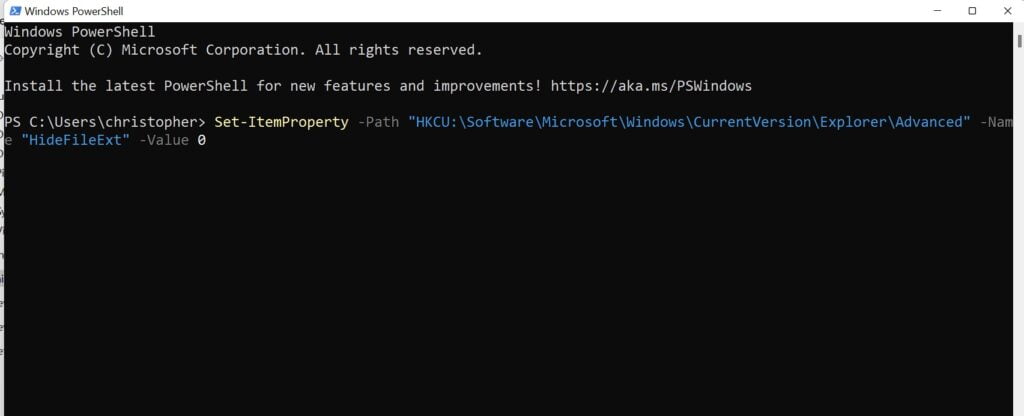Contents
In this comprehensive guide, I will walk you through the step-by-step process on How to Change File Extension Windows 11. From basic methods to advanced techniques, I will cover everything you need to know to confidently navigate file extensions and make the necessary changes. By the end of this guide, you will be equipped with the knowledge to modify, convert, or alter file extensions with ease.
Let’s dive in and explore the fascinating world of file type extensions!

How to Enable File Extension Visibility in Windows 11
In this section, I will provide step-by-step instructions on how to enable file extension visibility in Windows 11. I will explain two methods: using File Explorer Options and using PowerShell. These methods will allow users to easily view file extensions and make changes to them.
Using File Explorer Options
To enable file extension visibility using File Explorer Options:
- Open File Explorer by clicking on the folder icon in the taskbar or pressing the Windows key + E.
- Click on the “View” tab at the top of the window.
- In the “Show/hide” group, check the box that says “File name extensions”.

Once you’ve completed these steps, file extensions will be visible for all files in File Explorer.
How to Change File Extension Windows 11: By renaming the file
First, locate the file you want to change and right-click on it.
From the context menu that appears, select “Rename.”
This action will enable you to edit the file name.
Now, replace the existing file extension with the desired one.
Make sure to choose a valid, supported file extension to ensure compatibility.
It’s important to note that changing the file extension does not convert the file format. It merely tells the operating system which program to use when attempting to open the file. Therefore, it’s crucial to select the appropriate file extension that matches the file’s actual format. By following these steps, you’ll be able to change file extensions easily and alleviate compatibility issues on your Windows 11 device.
By using Save As option
How to change file extension Windows 11 using save as option, simply follow these steps.
First, open the document you wish to modify and click on the “File” tab in the top left corner.
Next, select the “Save As” option from the dropdown menu.
A new window will appear where you can choose the desired location to save the file and rename it if necessary.
Before clicking “Save,” make sure to select the “Save as type” dropdown menu and choose the format you want to convert the document into.
“Save As” is not limited to document files but can also be used for images and other file types. For example, if you have a JPEG image and want to convert it to a PNG file, simply follow the same steps mentioned above. Find your image file, click “Save As,” choose your desired location and new file name, and select PNG from the “Save as type” dropdown menu. Click “Save” and voila, your image is now in the desired format.
Using Command Prompt
In this section we are going to see, how to change file extension windows 11 using command prompt.
For example, if you want to change a file named “example.txt” to “example.docx,” you would type
“ren example.txt example.docx” and hit Enter.
The Command Prompt will then execute the command, and the file extension will be changed.
Using PowerShell to Show File Extensions
If you prefer using PowerShell to enable file extension visibility, follow these steps:
- Open PowerShell by right-clicking on the Start button and selecting “Windows PowerShell” or “Windows PowerShell (Admin)”.
- Enter the following command and press Enter:
Set-ItemProperty -Path "HKCU:\Software\Microsoft\Windows\CurrentVersion\Explorer\Advanced" -Name "HideFileExt" -Value 0

After executing this command, file extensions will be visible in File Explorer and other system dialogs.
Advanced Methods to Change File Extensions
In this section, I will explore advanced methods for changing file extensions, providing you with more flexibility and control over your files. These methods are especially useful when you need to rename multiple files at once or make changes not easily achievable through regular file properties.
Batch Renaming Files Using PowerShell
If you have a large number of files that need their extensions changed, using PowerShell can save you considerable time and effort. With PowerShell scripting, you can automate the process to bulk change file extension in Windows 11/Windows 10, making it ideal for tasks such as adding a consistent extension to multiple files or replacing existing extensions with new ones.
Here’s an example of a PowerShell script that renames all files in a specified folder by changing their extensions:
Get-ChildItem -Path “C:\FilePath” | Rename-Item -NewName { $_.Name -replace ‘\..*’, ‘.newExtension’ }

Note: Replace “C:\FilePath” with the actual path to the folder containing the files you want to rename and “newExtension” with the desired extension. This script will rename all files in the specified folder with the new extension.
Changing File Extensions Using Windows Registry (Advanced Users)
For advanced users familiar with the Windows Registry, changing file extensions directly in the registry can provide even more control and customization options. However, it’s important to proceed with caution when making changes to the registry, as any incorrect modifications can cause system instability or errors.
To change a file extension using the Windows Registry:
- Open the Windows Registry Editor by pressing Win + R, typing regedit, and clicking OK.
- Navigate to the following key: HKEY_CLASSES_ROOT\.oldExtension
- Right-click on the .oldExtension key and select Rename.
- Change the extension to the desired new extension.
- Exit the Registry Editor.
Note: Replace “.oldExtension” with the file extension you want to change and “.newExtension” with the desired new extension.
It’s essential to create a backup of the registry before making any changes and to proceed with caution. Incorrect modifications to the registry can lead to system instability or other issues.
Remember, these advanced methods require technical knowledge and expertise. If you’re not familiar with PowerShell scripting or the Windows Registry, it’s recommended to stick with the simpler methods discussed earlier in this guide.
Now that you’re familiar with these advanced methods, you have more options to efficiently change file extensions in Windows according to your specific needs.

By following these steps, you can manually revert the file extension for individual files to their original state.
Remember to exercise caution when making changes to file extensions and always ensure that you have a backup of your important files. Reverting changes can help you restore file compatibility and maintain an organized file system on your Windows computer.
Conclusion: Maximizing Efficiency and Safety
After exploring the various methods to change file extensions in Windows 11, it’s clear that efficiency and safety are key factors to consider. By following the best practices outlined in this guide, users can easily modify file extensions while minimizing the risk of data loss or compatibility issues.
